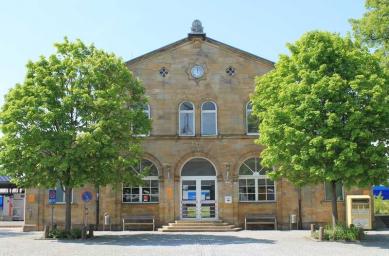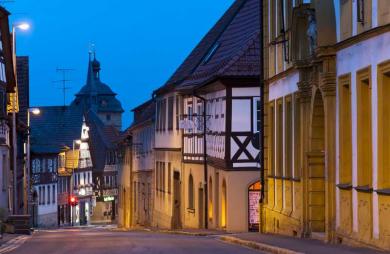The history of Bad Staffelstein

Bad Staffelstein looks back on an eventful history. The town has existed for over 1200 years and has experienced many high points such as its recent recognition as a spa town and its development into a popular tourist destination.
The first traces of settlement date back to 1 century BC. The town was
first mentioned in a deed of donation around the year 800. In this deed, a
countess called Blitrud bequeathed her land in Staffelstein to the Abbey of
Fulda. Even after the Bamberg diocese was later established in 1007 by the future
Holy Roman Emperor Henry II, the parish was part of the Würzburg diocese. This
is why Bad Staffelstein parish church is dedicated to the patron of the
Würzburg diocese, Saint Kilian.
In the end, however, the parish of Staffelstein was given to the Bamberg cathedral
chapter “to manage and benefit from”. In 1416 the town was given to the
cathedral dean of the cathedral chapter as a newly established “Staffelstein
charge”.
The Bamberg cathedral chapter once had Saint George as its patron saint,
which is why he still features today in the Bad Staffelstein coat of arms and
is also the patron saint of the town.
The Staffelstein Town Charter:
At the insistence of the cathedral chapter and its provost Eberhard,
Staffelstein was awarded market rights in 1130 at a gathering of princes in
Bamberg. In 1422, Prince-Bishop Friedrich III of Aufseß approved the
fortification of the town with moats, walls and towers. In 1473 the notorious
robber baron Ulla von der Weiden (Ulla of the Willows) set Staffelstein on
fire, as a result of which the town hall and church were destroyed. The town’s
defences were not enough to protect Staffelstein from the worst devastation in
its history during the 30 years’ war.
On 7 February 1633, the Swedish soldiers attacked the town and 133 inhabitants
of Staffelstein were killed. In 1634, Staffelstein was so stricken with plague
that the population was decimated hugely with 400 deaths. Fires continually
broke out in the town. In the great fire of 5 July 1684, 330 buildings burned
down, only the parish church and some peripheral houses were not seized by the
flames. Afterwards, the ruins were rebuilt quickly yet skilfully in
timber-frame technique. Today, these buildings are the flagship of the town and
are under conservation protection.
Staffelstein Train Station

In the 19th century, the construction of the train station brought about a break in the town history. In January 1846, the town was connected to the Ludwig-South-North-Railway from Lake Constance to Hof. The train station was situated far out of the town; however, it was conveniently located between the town and Banz Abbey. Today, the station is situated centrally between the old town and the spa resort.
Staffelstein’s Rise to District Seat

Staffelstein grew constantly. In 1862 there were 1,400 inhabitants; 20 years
later there were already 1,900. On the Bahnhofstraße, where it once was so marshy,
rose magnificent town houses. A central plumbing system exists since 1890 (the
first wooden precursors had been there since the 15 th century
already), the hospital was opened 8 years later with 34 beds. Since 1904,
Staffelstein has a telephone network and 1907 brought electricity to the town.
In the same year, test production for a “Staffelstein car” even began.
The town changed like this at a rapid pace. As Staffelstein strived for a
modern image, the historical flair of the town was perceived as disturbing.
Even the town gates – with the exception of the Bamberg Gate – had to give way
to this, and part of the town wall was torn down in the 1880s. However, large
parts of the mighty structure can still be seen. At the beginning of the 19 th
century, the Hausen porcelain manufacture went through a boom phase and could
employ 150 workers at its peak period. There were also several “furniture
factories”, or larger carpentry businesses.
The steam brewery “Dampfbrauerei Brütting” managed to broaden their sales
market and export their beer up to northern Germany. Brush, furniture and cigar
factories settled into Staffelstein.
Staffelstein in the Second World War and the Post-war Era
Both world wars left clear marks in town life. Just like everywhere else,
countless inhabitants of Staffelstein lost their lives in the First and Second World
War. From 1933, the region at the Upper Main was under observation from the
National Socialists.
Staffelstein was taken by American troops just before the end of the war,
in the afternoon of 12 April 1945, shortly after the first streams of refugees
had arrived.

After the war, many things changed. Before the war, the number of inhabitants had been 2,300, which increased to 3,650 up until 1950 due to displaced people and refugees. Many Protestants now belonged to a region characterised by Catholicism. As the prayer hall had become too small, the Dreieinigkeitskirche (Trinity Church) was built between 1955 and 1957 on Georg-Herpich-Platz. On 1 July 1972, Staffelstein lost its status as district seat due to the district reform. Today, the large municipality covers 38 villages and hamlets and stretches over almost 100 square kilometres. The number of inhabitants has passed the 10,000 mark.
The foundation stone for Bad Staffelstein’s recent touristic development was first laid in the 1970s. The Lautergrund inhabitants’ first encounters with “strangers” mainly took place with patients and guests in the Schwabthal wellness clinic, a sanatorium for lung patients for the BfA (the German Federal Insurance Fund for Salaried Employees). However, the drilling of a 1,600-metre-deep hole in the summer of 1975 was relevant to the development of today’s spa town. This was where the hottest and strongest of Bavaria’s salt water was discovered – hot thermal salt water from 47 to 52 degrees Celsius, containing carbon dioxide and iron. In 1986 the thermal bath Obermain Therme opened, which meanwhile has been expanded several times. Since 1995 the Schön Klinik Bad Staffelstein has been open as a rehabilitation clinic and the spa park was set up in 1999.
Staffelstein as a Spa Town
On 15 November 2001, 26 years after the thermal source was discovered,
Staffelstein was officially recognised as a health spa. Since then, the town is
known as “Bad” Staffelstein.


